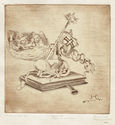
19th, 20th & 21st Century Fine Prints
707-546-7352 · fax 707-546-7924 · web: www.annexgalleries.com · email: artannex@aol.com
Federico Cantu Biography
Federico Cantu
Mexican
1907–1989
Biography
Federico Heraclio Cantú Garza was born on March 3, 1907 in Monterrey, Mexico to María Luiza Garza, a novelist, and Adolfo Cantú, a journalist who opposed the Porfiro Diaz regime. He was born shortly before the Mexican Revolution and spent his childhood split between Nuevo Leon and San Antonio, Texas. The family moved back permanently to Mexico in the 1920s. Later in life, he changed his birth year to 1908 and his birthplace to Cadereyta Jimenez where his family was originally from. In 1922, at age 14, Cantú entered the Escuela de Pintura al Aire Libre, which was directed by Alfredo Ramos Martinez where he had contact with the growing Mexican muralism movement and briefly studied fresco painting under Diego Rivera in 1924.
From 1924 to 1934, he traveled and lived in Europe and the United States. He first went to live in Paris on Rue Delambre in Montparnasse at age sixteen. During his time in Europe he met various artists of the avant garde of the time, including Picasso, Alfonso Reyes, poet César Vallejo and sculptor Mateo Hernández. He studied with sculptor Jose de Creeft. When he lived in Paris, he gathered a collection of drawings called the "Paris Collection" by his son Federico Cantu Fabila (FCF). However, during his time there, he created over two chests of drawings made at Le Grande Chaumiere. These chests were lost. In 1929, he married his first wife, Luz Fabila Montes de Oca.
Cantu's trips in the United States were short periods. He left Europe for Mexico in 1934. In the 1930s, he joined a group of painters with the Inés Amor gallery but soon after, established a studio in New York, as friends of his from Montparnasse were there to escape the Second World War.
Cantú's career extended over 65 years and included exhibitions, monumental works, design, illustrations and more. From 1924 to 1931 he exhibited his work in the United States and Europe, with his first exhibition occurring at the Exposition Park Museum in Los Angeles. His first exhibition in Mexico was in 1933 at the Salón de Arte of the Secretaria de Educacion Publica . While living in New York, he took part in several collective shows. He had much of his success in these two places, with other shows at Tate Gallery in London, the Museum of Modern Art, the Macy's Gallery and the Perls Gallery in New York.
Cantu narrated in his memoirs that he left the atelier of Paris to settle in Los Angeles California where he began his monumental career in sacred art, after a request promoted by a parish priest from Pasadena, where he painted a series of works that would include the plot of the black Christ as well as a series of Madonnas for the presbytery of the Church of Pasadena California in 1928.
Cantú taught both in Mexico and the United States. In the 1940s, he was an instructor at the Escuela Nacional de Pintera, Escultura y Grabado "La Esmeralda" In 1951 he was a guest lecturer at the University of California, Los Angeles.
Federico Cantu Garza died in Mexico City on January 29, 1989. His remains are at the foot of his mural Dios Padre y crucifixion (1959) at the chapel of the Universidad Intercontinental in Tlalpan, Mexico.


